PIN HIGH CLINICS IN ETIOLLES AUGUST 8th to AUGUST 12th
AIM OF THE CLINIC :
- Improving your technical acknowledges or learn what to do in the future.
The aim is not to change all you learnt before (advanced), but to show you the
way towards a better swing.
- Personal adaptation to these technical drills because the bodies are not the
same. In fact, what is important is to control the impact zone, not to move the
right way.
- Set up of a more confident swing, to show you that you're able (beginners) to
go on the course very quickly and avoid future physical
problems
Anyway, there won't be any difference between "beginners language" and "advanced language". We will not learn "WHAT TO DO" but "WHY TO DO IT". We will not change anything about what you learnt before. We will just help you to know what to do.
Advice : Beware what you look at. As you're (as everybody in the world) looking "at" the ball, you are so looking at the top of the ball. In the deep grass, this could be a way to top the ball, because you want the club to go back to where you look. You should so look at the grass behind (or before, if you prefer) the ball. This will help you to hit the grass, instead of topping the ball.
The order of the things is "fingers - arms - shoulders". So if you want the ball to roll, the backswing will be short and the follow through willbe helped by turning the shoulders during the impact. For the ball to fly, the backswing will be wider and the fingers and wrists ( instead of shoulders) will help to make the ball fly higher.
Position : Hitting line in the middle of the stance, weight on the left foot (burying the foot), ball a little left of the hitting line. Remember that the perpendicular to club face must be able to pass over the "wall". Otherwise, it will be impossible to throw the ball out.
PRESENTATION OF THE METHOD :
To hit a golf ball properly, you need to respect a few fundamental rules :
- The hitting posture is
the same as the starting
posture
- The swing is as symetrical as possible (The
finishing posture is a consequence of the speed, not an obligation)
- The path of the club is the same during the backswing
and the downswing
What is going to be important is the fact that you have to find the points you
have to pass by, instead of the physical way you have to move . You have to
decide, too, what you really want to do. "Hitting the ball well" is
not the right answer, because to do so, you must respect too many rules at the
same time. We have to build the swing step by step, so that you just think about
one thing at the same time.
Finish : The fact to turn your shoulders towards the target finishing the swing is a consequence of the speed of the swing. You don't have to think about it. That's what we're going to work on during the week.
AFTERNOON :
DAY 2 : Tuesday August 9th
I don't think we can give Putting lessons. This part of the game is quiet personal. It is a question of feeling, more than technic. But We could study some basics and give some drills to improve in the future.
AROUND THE GREEN :
Chipping with 9 iron or 7 iron on the sloppy green:
- The swing must look like a clock. We saw that you can imagine three widths for the swing :
LONG SHOTS ON THE DRIVING RANGE :
Concerning the top of the backswing, I can give you a last advice.
The "important things" at that point of the swing are : right arm parrallel to the ground and the shaft making an angle of 90° with the right forearm.
EXERCISES : Do the backswing so that the club points in from of you at the top, instead of towards the target. As you try to bring it back to the ball, you feel that you need to use your hips and legs to help the swing. This is the feeling you should always have.
When you hit the ball, think "RIGHT HAND / RIGHT KNEE / RIGHT SHOULDER"
THE WRISTS : The control of the wrists (in fact the fingers, as we explained it) helps to control the direction of the ball. Most of the time, you're not trying to send the ball straight. You're preventing the ball from flying to the right or to the left. That's why you can't correct the fact that the ball flies to the right if you can't make it fly to the left on purpose. You'll be able to feel the importance of the wrists (closing or opening the club face during the impact zone) only if you stay what we called "behind the ball". That means at the moment you hit the ball, your head shouldn't be over the ball or more on the left (for right-handed players). Your head was behind the ball while you were addressing the ball, it has to stay behind while you hit.
THE SIX PARTS OF THE SWING :
AFTERNOON ON THE COURSE :
Much better than yesterday. As you could see, you learn more on the course than on the driving range. The pressure is not the same.
We worked on the little high chips. You need the SW to do so. The ball lies in the middle of the stance, the weight of the body is a little on the left foot, to help you to contact the ground easier. The swing is made by the wrists on the backswing, but you have to control that you don't unload during the hit, otherwise you will top the ball. You must think that the club face looks like a spoon.
Remember that the distance from the ball is given by 3 ways :
Working on half shots to feel the way to give speed to the club face :
Remember the "points of pressure". These are the parts of your body able to help the club to gain speed. Your shoulders will be the last part to be used. The points of pressure are : Right forearm (for right-handed), the legs (making the weight transfer) and the wrists (giving more speed to the club while hitting the ball)
Exercises :
1 - Take the position as if you want to hit the ball
- Once you have found the right posture and distance, put your feet together (left one towards the right one), club in front of you
DAY 4 : Thursday August 11th
PUTTING Exercises:
Put a coin down on the green to aim this point and forget the hole. Anyway, the target is almost never the hole itself. Most of the greens are too much sloppy for that. Remember the exercises to practice putting (5 balls in a row or 5 balls around the hole). Try to practice putting and chipping at the same time, as we did..
LONG SHOTS :
2 - Take one club in each hand and try to swing them so that they don't touch each other during the swing. This is to help you to feel the association between the right side and the left side.
WOOD ON A TEE :- The main difference is in the distance from the ball. As the swing will be wider and faster down, the strike will happen "higher" than usual, that means a few centimeters over the ground. If the club lies just behind the ball, you will hit the ball in the heel of the club. So you're going to miss the ball. You have to set up with the club "beside" the ball. Just lifting the hands up, you see that the club face is perfectly against the ball. So you can find it easier during the downswing.
- The posture is your own. It depends on the size, the elasticity of the body, the weight and many other things.
We saw that the weight transfer is necessary to give power to the strike. You have to feel that the weight tranfer begins just at the moment you begin to swing your hands down back to the ball. That is going to help your body to turn while hitting.
If you want to understand better, just remember what we said about the "9 trajectories". Right, left, straight and two spins per family. That means nine possible trajectories. The shaft gives the first direction and the way the club is opened or closed in the hitting zone gives the end of the flight.
Remember ! (1) The ball will fly low when you use your shoulders more than your knees and arms and it will fly higher if you hit the ball without turning your shoulders before hitting the ball. (2) Your right arm must finish "outside" of your body after you hit the ball. This will help you to control the direction and will help to make the ball fly.
DAY 5 : Friday August 10th
Today is a relaxing day. We practiced a few of the shots we learnt this week, just to remember the last advices. We've been working a lot this week and I think that you all improved your acknowledges and your swing. Now you need to gain confidence in yourself by playing more and more. To finish our clinic, the best way is to have an individual report on what you're supposed to work in the future. So I hope these pictures will help you to do so.

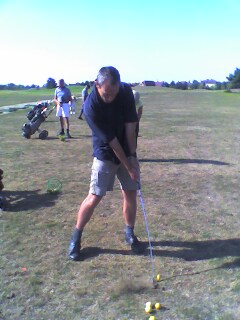
 |
As you can see on the first picture, the backswing is perfect (club shaft showing the ball, hands beside the neck). The follow through (3rd picture) could be more towards the target than towards the sky, because the backswing is not that high. What has to be improved is the "hitting posture" : You face the ball, arms are straight, but the legs must move faster to help the club to go towards the target, as we said before. |

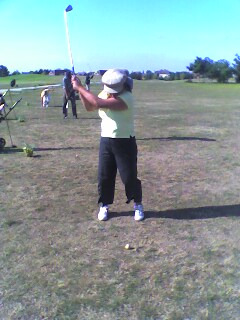
 |
Good posture on the first picture. On the backswing, you should load your wrists a little bit more (90° between the arm and the shaft) to be able to give more speed during the downswing. Your legs move very well during the hitting zone, but as you see, your arms could straighten more towards the target (Position N° 5). |
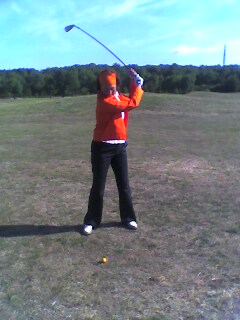


|
First and third pictures are quiet good. On the backswing, it could be "wider" as it is on the finishing position. That could help you to have a better circle. Was you have to work on is the hitting position. As you see on the middle picture, your legs didn't move at all and so your arms can't straighten. It is the reason why you sometimes top the ball or loose power. |

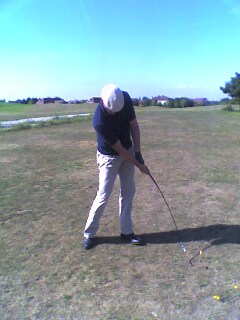

|
You must try to improve according to the third picture. This is a perfect position (arms straight, weight on the left foot, hips facing the target). So you should swing back wider (that means higher), moving your knees a little bit more to help the rotation of the shoulders (first picture). The hitting position (middle picture) is almost good. Just use your legs a little more to help the club to go through the ball and lead you to the finishing position. |
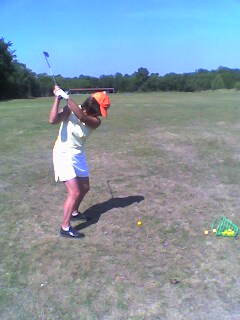
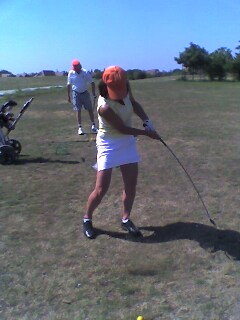

|
There's not much to improve. The third picture was the one we did on purpose, without ball. You can see comparing to the second picture that just the weight transfer (legs) could be improved. That would help the arms to straighten better. The first picture is perfect with the legs, but it looks like your hands are a little bit too much "behind" you, instead of "over your neck". |
|
|
Very good posture on the first picture. The club shaft is showing the ball, your legs helped the shoulders to turn. On he second picture, your head is almost "over" the left foot, which is a little bit too much. You head were "behind" the ball before you began the swing, so it has to be still behind at the moment you hit it. Good job with the legs. If you have some more pictures, send them to me, and I'll send you the comments back. |
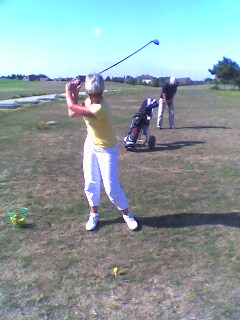


|
Very good backswing (weight on the right foot, club 90° with the arm, head behind the ball). Problem is at the moment you hit the ball : Your legs (knees) should move faster to help your arms to straighten and give speed to the club. You see that the mistake makes your head move "down" during the hitting zone. Finishing position is relax, weight on the left, but your arms are not absolutely straight (Position N° 5) |
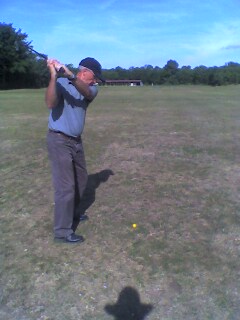


|
Top of the backswing is almost good. What could be improved is that the club shaft is not absolutely "showing" the ball (remeber "show the line). That's going to help the club to finish to the left instead opf towards the target. I think it would be better if you have a shorter backswing as you do on the middle picture. So it would be the same as your finishing position (Position N° 5) |

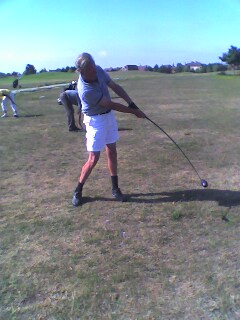

|
Backswing is perfect (Club 90° with the arm, weight on the right, head behind the ball). The problem is that you leave your head there while swinging down. Your head should move back to where it was when you were addressing the ball (behind the ball, but not that much). That prevents you from transferring the weight (middle picture). Follow through is quiet good. Don't forget to straighten your arms towards the target first before finishing the swing. |
I want to tell you that I enjoyed a lot to work with all of you (I repeat that every week, but I really mean it) and I hope to see you again in another PinHigh location
TOT ZIENST !